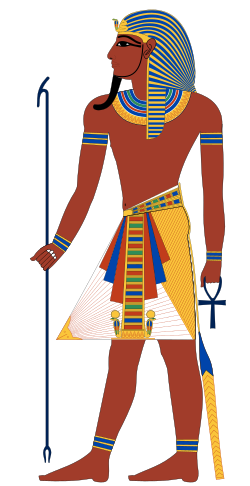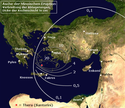15. dynastie
15. dynastie
| |||||||||||
Geografie
| |||||||||||
| Obyvatelstvo | |||||||||||
| Státní útvar | |||||||||||
| Státní útvary a území | |||||||||||
| |||||||||||
| Hyksos (řecky) Hykussos (Ὑκουσσώς, Ὑκσώς, Ὑξώς)[1] v hieroglyfickém zápisu | |||||||
|---|---|---|---|---|---|---|---|
ḥqȝ(w)-ḫȝswt [2] |
15. dynastie, nazývaná jako hyksóská dynastie, byla jednou ze staroegyptských královských dynastií řazených egyptology do historického období Druhé přechodné doby. Vládla přibližně v letech 1650–1550 př. n. l.[3]
Historický vývoj




Původ Hyksosů je dosud nejasný, historici se však shodují, že jejich jednotlivé skupiny nomádů přicházely do delty Nilu z asijského východu. Jejich jazyk a kultura měly semitské prvky charakteristické pro syro-palestinské populace. Zdá se však, že byli etnicky smíšení, včetně značného semitského prvku, protože fénická božstva El[p 1], Baal a Anat figurovala v jejich panteonu . Hyksosové do Dolního Egyptu imigrovali několik desetiletí od počátku Druhého přechodového období,[4] zhruba od konce 12. dynastie a vytvářeli vlastní rodové komunity, takže ke konci 14. dynastie byla původní egyptská populace natolik oslabena, že se vlády v lokalitě města Avarais ujal hyksoský král Salitis (~1630 př. n. l.).[5] Město opevnil valem, ustavil vojenskou posádku a postupně ovládl Dolní Egypt a vyvíjel vojenský tlak na jih Egypta, kde se souběžně utvářela mocenská struktura v Thébách, která se uvádí jako 16. dynastie. Egypt byl mocensky rozdělen, i když se zmiňuje vazalská pozice Théb vůči hysksóským králům v Avaris.[6]
Panovníci
| Král | rodné jméno | trůní jména | období př. n. l.[3] | poznámky [7] | ||||||||||||||||||||||||||||
|---|---|---|---|---|---|---|---|---|---|---|---|---|---|---|---|---|---|---|---|---|---|---|---|---|---|---|---|---|---|---|---|---|
| Salitis | 1630–1615 | Vybudoval obranbý val kolem Avaris proti vpádu z jihu | ||||||||||||||||||||||||||||||
| Bnon | 1615–1602 | záznam podle Manehta | ||||||||||||||||||||||||||||||
| Apacnan | 1602–1594 | [8] | ||||||||||||||||||||||||||||||
| Chaian | 1594–1574 | Nález hrobky v Tell el-Dab'a, sídlo 15. dynastie Avaris[9] | ||||||||||||||||||||||||||||||
| Apofis I | 1574–1534 | Záznam o královně Herit, dcera Apofise I. | ||||||||||||||||||||||||||||||
| Apofis II | 1534–1525 | [10] | ||||||||||||||||||||||||||||||
| Jamudy | ~1525 | Záznam v Turinském papyrusu; obelisk v sídle Avaris[7] |
Vnější podmínky


V 16. století př. n. l. ve středomoří se realizoval bohatý výměnný obchod, různých komodit, těžba nerostů, řemeslných výrobků, jak dokládají četné roztroušené archeologické nálezy, například Mínojské civilizace na společensky vyspělém ostrově Kréta. Zmíněné ekonomiko-politické vztahy byly náhle rozrušeny obrovskou erupcí sopky Santorin na Krétě, ke které došlo, podle radiokarbonových analýzy, v roce ~1646 ±35 roků př. n. l.[11] Minojská civilizace byla zničena, do atmosféry bylo vyvrženo ~ 30 m³, celá oblast byla zasypána prachem s důsledkem na podnebí. Došlo k poklesu teploty, spadu aerosolu siřičitanů a v neposlední řadě obrovské devastaci pobřeží vzedmutím moře vlnou tsunami o výšce vyšší než 60 m. To vše nepochybně ovlivnilo i oblast v rozsahu od Libye až po deltu Nilu. Chronologicky to koresponduje s vládou 15. dynastie, nejspíše s vládou prvních tří králů Salitise a Bnona a Apacnana v rozmezí 1630–1600 př. n. l.[12] Záznam o neobvyklé bouři a zátopách Nilu se zachovaly na stéle Tempest na třetím pylonu v Karnaku,[13] které jsou historiky spojovány s erupcí sopky Santorin.[14]
Odkazy
Poznámky
- ↑ semitský bůh/>, Akkad, Babylonie
Reference
- ↑ Folker Siegert: Flavius Josephus: Über die Ursprünglichkeit des Judentums. p. 111.
- ↑ Rainer Hannig: Großes Handwörterbuch Ägyptisch-Deutsch : (2800-950 v. Chr.). von Zabern, Mainz 2006, ISBN 3-8053-1771-9, p. 606 and 628–629.
- ↑ a b BOURRIAU, Janine. The Second Intermediate Period (c.1650-1550 BC) [online]. New York: Oxford University Press, 2000. S. 172–206. Dostupné online. ISBN 978-0-19-280458-7. (anglicky)
- ↑ BOOTH. The Hyksos Period in Egypt [online]. Princes Risborough, 2005. Dostupné online. ISBN 0-7478-0638-1. (anglicky)
- ↑ MOURAD, Anna‐Latifa. Rise of the Hyksos. Sydney: Macquarie University, 2014. (anglicky)
- ↑ ENBERG, Robert. The Hyksos reconstruction [online]. University Chocago, 1939. Dostupné online. (anglicky)
- ↑ a b BUNSON, Margaret. Encyclpedie of Ancient Egypt [online]. New York: Facts On File, Inc., 1991. Dostupné v archivu pořízeném dne 2021-08-30. (anglicky)
- ↑ FRANKE, Detlef. Personendaten aus dem Mittleren Reich (20.-16. Jahrhundert v. Chr.. [s.l.]: Harrassowitz, 1984. ISBN 9783447024846.
- ↑ FERSTEN-MÜLLER, Irene. King Khyan and Avaris [online]. Vídeň: Austrian Archaeological Institute, 2018. Dostupné online. (anglicky)
- ↑ GRIMAL, Nicolás. Historia del Antiguo Egipto.. [s.l.]: Ediciones Akal, 1996. ISBN 84-460-0621-9.
- ↑ MCCOY, Floyd, Heiken Grant. Tsunami genereted by the LateBrnoz age eruption of Thera (Santorini) Greece [online]. Basel: Birkhhäuser Verlag, 2000. Dostupné v archivu pořízeném dne 2018-03-06. (anglicky)
- ↑ Floyd, Papadopulos, McCoy. Modelling of tsunami generated by the giant Late Bronze Age eruption of Thera, South Aegean Sea, Greece. Geophysical Journa International. April 2011, čís. 4, s. https://academic.oup.com/gji/pages/About. ISSN 0956-540X.
- ↑ SHAW, Ian. The Oxford History of Ancient Egypt. Liverpool: University Liverpoole, 2002.
- ↑ DAVIS, E.N. Thera and the Aegean World III. New York: The Thera Foundation, 1989. ISBN 0-9506133-6-3. Poceedings of the Third International Congress, Santorini, Greece.
Literatura
- The Hyksos Reconsidered, Robert Engberg, University Chicago, 1939 [1]
- Cesty starověkých civilizací, Jan Burian, Praha 1973
Související články
Externí odkazy
 Obrázky, zvuky či videa k tématu 15. dynastie na Wikimedia Commons
Obrázky, zvuky či videa k tématu 15. dynastie na Wikimedia Commons
Média použitá na této stránce
Autor: Tim Evanson from Cleveland Heights, Ohio, USA, Licence: CC BY-SA 2.0
Flat-faced scarab, created in Egypt about 1648 to 1540 BC. Found in Egypt, but the location is not clear. Finger ring, composed of a blue glazed steatite scarab (type D2) mounted in a gold mount. The scarab bears the cartouche of the hyksos ruler Khyan:
| |
Autor: Jeff Dahl, Licence: CC BY-SA 4.0
The double crown symbolizing dominion over upper and lower Egypt.
Statues of Amenemhat III
Old text:
BPLDC no.: 08_04_000037
Page Title: Hycsos Sphinx[es]
Collection: Tupper Scrapbooks Collection
Album: Volume 26: Lower Egypt. Pyramids.
Call no. 4098B.104 v26 (p. 36)
Creator: Tupper, William Vaughn
Description: Scrapbook page containing a photograph of Egyptian sphinx statues, annotated with information about the statues. The page also includes three drawings of cartouches and information about the Hyksos dynasty.
Subjects:
Egyptian (ancient)
statue
Sphinxes
Page size: 33 x 38.1 cm
Annotations: Mariette 1863. Considered by him "comme des produits de l'art des Pasteurs." [‘to be the works of the art of the Shepherds, i.e., the Hyksos’] "These differ from other Egyptian monuments in a very marked way as one sees by comparing them with the Sphinx[es] of Tutmes III and Ramses II. The face is round, the eyes are small, the nose flattened, the cheek bones projecting, the lower lip sliphtly advanced, the ears are those of a bull while the mane of a lion encircles the visage." [« Ils se distinguent en effet des autres maonuments par des caractères bien tranchés, comme on le reconnaîtra sans peine, si l'on compare leur tête à celle des sphinx de Thoutmôsis III et de Ramsès II. La face est ronde, les yeux sont petits, les narines écrasées, les pommettes saillantes: la lèvre inférieure avance légèrement ; les oreilles sont celles du taureau, et une crinière de lion encadre le visage. »][1] On one of them one can descipher the name of the Shepherd King Apopi [Apepa]. Later Meneptah erased the name and substituted his cartouches. Still later Pasebxanu XXI dynasty put his name on the breast [place of honor] erasing that of the monarch for whom it was graven. This gives ground for a German theory that it antedates "les Pasteurs" [Shepherds] and belongs to XII. Dynasty.
[Left of the photo:]
XVI.
Dynasty
Hyksos.
Apepa.
XIX
Dynasty
B.C. 1400
Thebes
Meneptah[,] pharoah of Exodus.
XXI Dynasty
Tanis
Pasebxanu I.
B.C. 1100.
Language: English and French, photograph titled in French
Rights: No known restrictions.
Coverage: Egypt
Notes: Title supplied by cataloger, derived from captions or annotated information.
Format: Scrapbooks
Technique: Photographs, Albumen prints
BPL Department: Print Department
Photo 1: Photographer: Sébah, J. Pascal
Title: 215 Sphinx Hycsos (Musée Ghizeh)
Caption: Hycsos Sphinx[es.] Excavations Tanis. Black Granite.
Date: ca. 1888-1890
Flickr data on 2011-08-03:
- Camera: Sinar AG Sinarback 54 FW, Sinar m
- License: CC BY 2.0
- User: Boston Public Library BPL
Autor: Didia, Licence: CC BY-SA 3.0
Map with reconstruction of the landscape of Avaris / Tell el-Dab'a (ca. 1500 BC) in the East side of the Delta of the Nile, in Upper Egypt ; Pelusian arm of the Nile ; project of the Österreichischen Archäologischen Instituts.
Autor: Jeff Dahl, Licence: CC BY-SA 4.0
Pharaoh, the king of ancient Egypt, is often depicted wearing the nemes headdress and an ornate shendyt. Based on New Kingdom tomb paintings.
Autor: Enyavar, Licence: CC BY-SA 4.0
Ancient Orient around 1600 BCE:
- Hyksos in Upper Egypt
- Old Hittite Empire invades Babylon
Autor: Jeff Dahl, Licence: CC BY-SA 4.0
Typical ancient Egyptian crook and flail. It symbolizes leadership and a powerful ruler
Ash from the Thera eruption.
Based on Friedrich, Walter (2000): Fire in the Sea: Natural History and the Legend of Atlantis, Cambridge: Cambridge University Press. ISBN 0-521-65290-1
Autor: NebMaatRa, Licence: CC BY-SA 3.0
Drawing of the famous depiction of the Aamu group.
Autor: Juan R. Lazaro, Licence: CC BY 2.0
Lion of the Hyksos king Seuserenre Khyan
• Conservation: London. British Museum, EA 987.
bibliography:
Labib, "Herrschaft der Hyksos." (1936), p. 32. Pl 8 [a].
Ryholt, K.S.B. "The Political Situation in Egypt During the Second Intermediate Period". 1997, p.384.









